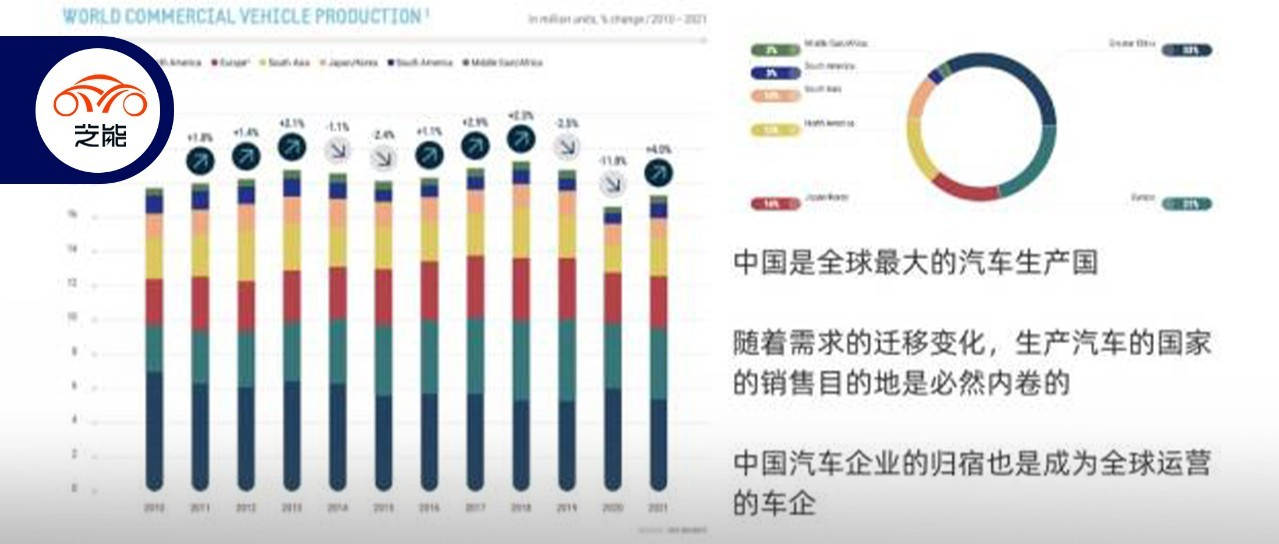Author: Tao Yanyan
When working with Teacher Zhu to sort out the development of new energy vehicles in Shanghai, it was shocking to see that the number of new energy vehicles registered in Shanghai for 2022 was as high as 326,000, with a penetration rate of 52.5%. Looking at the long term, it can be concluded that the peak of gasoline-powered cars has gone and will never come back, even if the subsequent new energy vehicle license auction is to take place, the overall situation has been determined.
In 2019, the number of new energy vehicles in Shanghai was only 60,000, and now the development has already reached “the gibbons call across the river, the boat has passed thousands of mountains”.
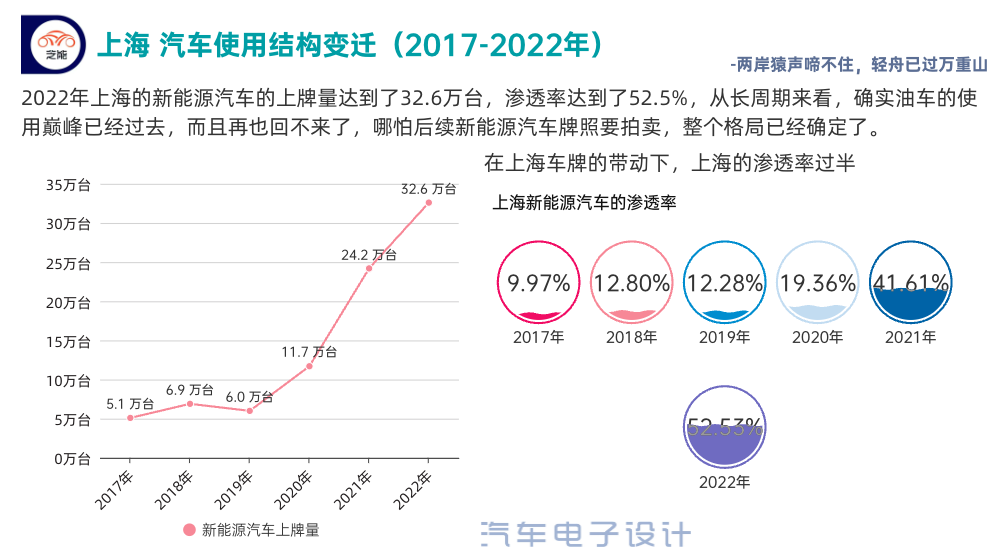
From 2017 to 2022, except for imported cars which have remained stable, both domestic sedans and SUVs have experienced significant decline, while the number of new energy vehicles has skyrocketed from 51,000 to 326,000, a very significant change.
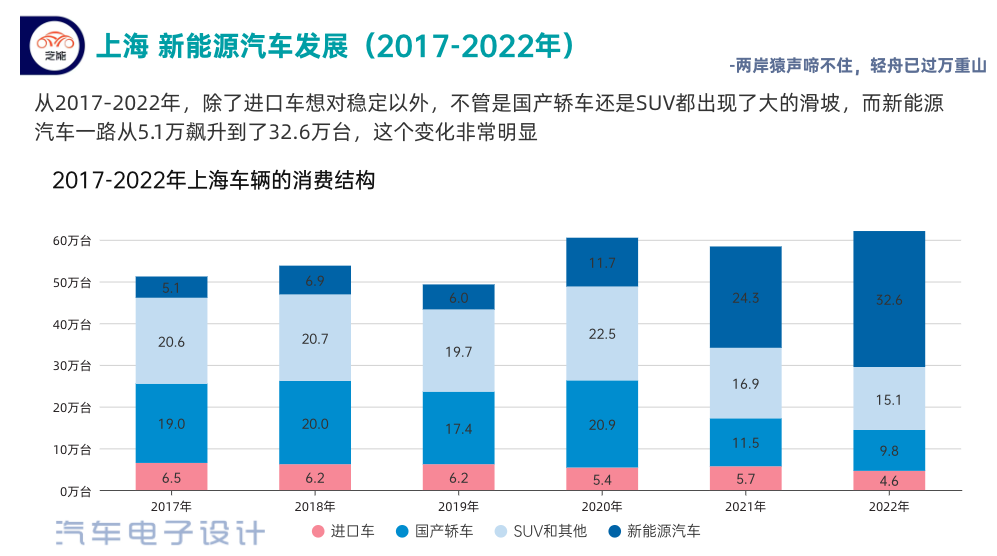
Review of the changes in the number of new energy vehicles registered in Shanghai
In December 2022, the total number of vehicles registered in Shanghai was 83,207, a year-on-year increase of 49.63%, of which 54,274 were new energy small cars – the penetration rate of which reached 69.9% for the month. As a (new) Shanghai resident, I feel that the auction system that once played a major role in regulating vehicles has become weaker, and my comrades in Shanghai have really become experts at gaming the system!
It is inevitable that the “free green license plate” policy will be phased out. This peak of 70% penetration rate made people realize that even if there was no green license plate policy, a penetration rate of 30%-40% could still be supported.
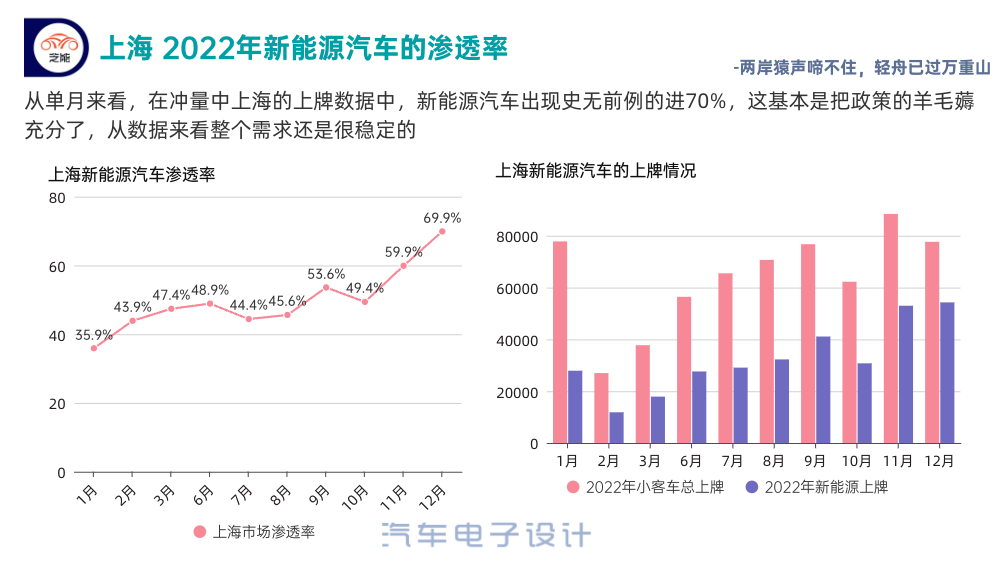
From the annual insurance data, there were over 120,000 PHEV plug-in electric vehicles and they accounted for about 17% of the market share in Shanghai in 2022, while there were 205,000 pure electric vehicles accounting for 28%. Consumers are sensitive to the differences and perceive that pure electric vehicles are more friendly to urban road conditions than plug-in hybrids.
◎Gasoline Vehicles: The top three are SAIC GM with 60,000, SAIC Volkswagen with 54,000, and FAW Volkswagen with 37,000.
◎New Energy Vehicles: BYD with 105,000, Tesla with 51,000, and SAIC with nearly 30,000.
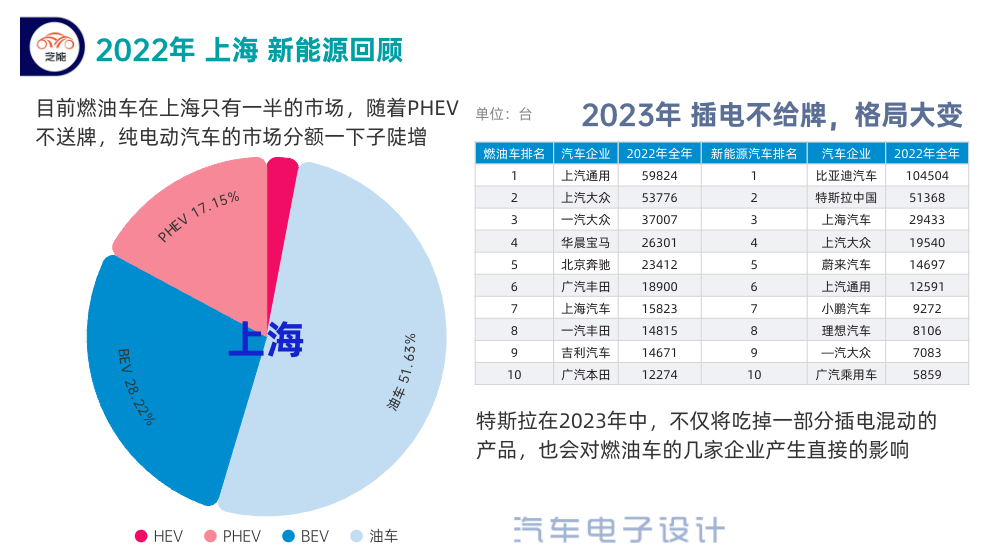
Looking at the data for December, there were 32,500 pure electric vehicles and 25,400 plug-in electric vehicles, which were registered to meet the deadline for obtaining a free green license plate.
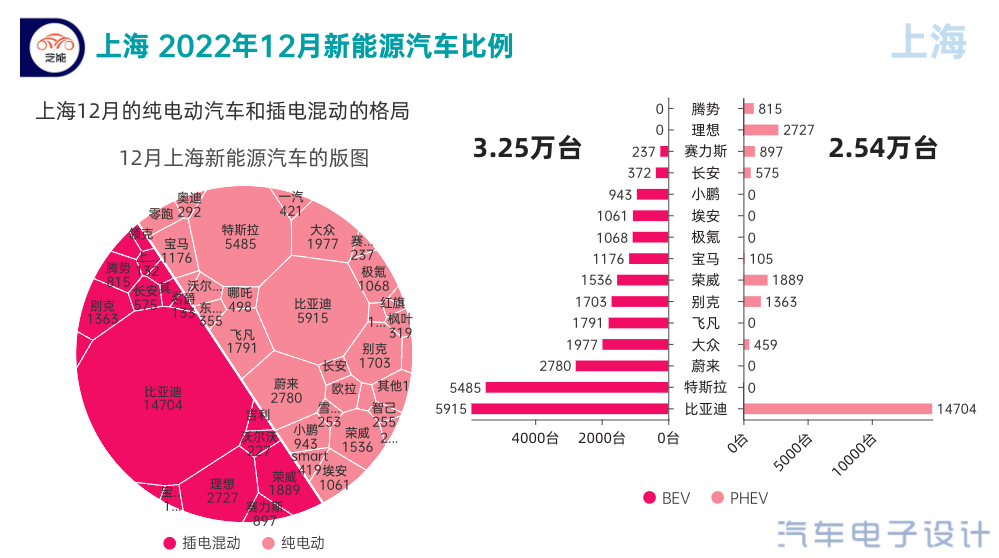
In 2022, there are over 120,000 plug-in electric vehicles in Shanghai, but there is a pessimistic estimate that in 2023, there will only be around 10,000-20,000 left (referring to Beijing’s data). The situation in Shanghai is unique – plug-in hybrid electric vehicles without blue license plates no longer offer good value (worth about 100,000 RMB).
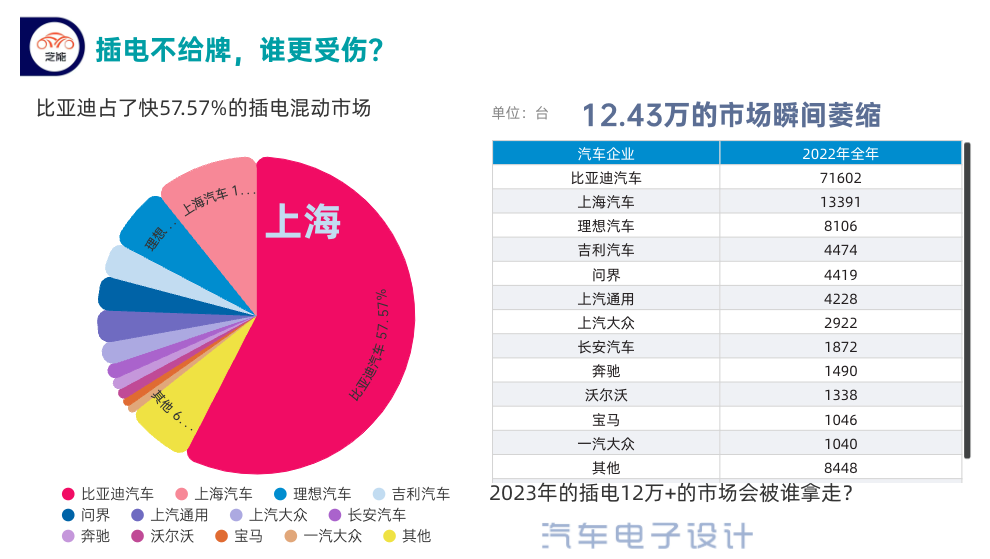
In 2022, the pure electric vehicle market in Shanghai focused mainly on Tesla, BYD, SAIC Volkswagen, NIO, and SAIC, among others. It is estimated that in 2023, with Tesla’s aggressive cost reduction, they will continue to dominate the market; BYD may have some plug-in hybrid conversions and remain second; and NIO, as a representative of new pure electric power, should stand out and obtain third place.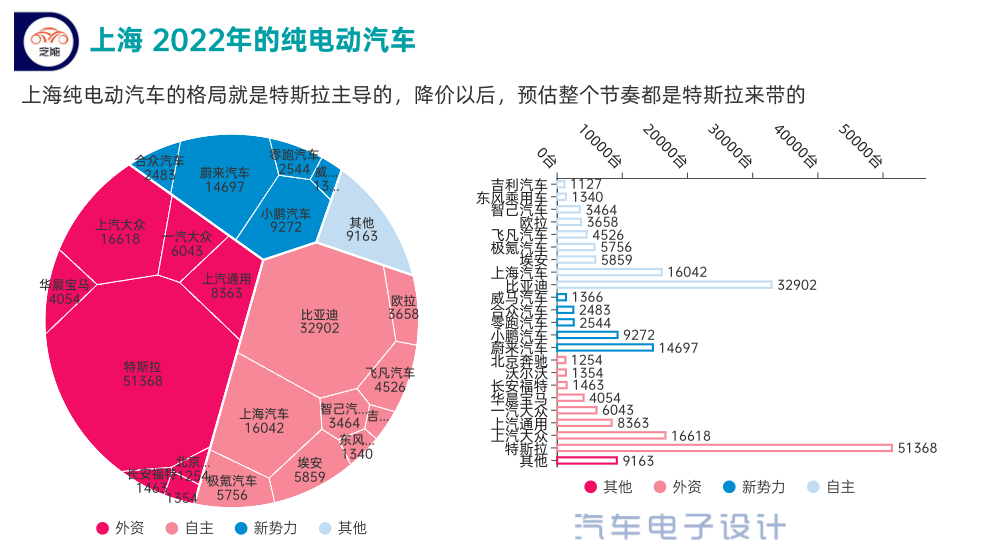
What Will Happen to Shanghai After 2023
In Shanghai, the right to use roads is essential. The auction of private car license plates began in 1986, and the auction system was established in 1992. In order to solve the traffic congestion problem in Shanghai, the auction system for newly added passenger car quotas was implemented for the first time in 1994. Shanghai began to implement a policy of bottom price, non-public auction for private car license plates. Buyers could purchase their cars and obtain the right to use motor vehicles without restriction in the central urban area of Shanghai (within the outer ring road) based on the quota obtained from winning the auction.
In the long run, due to the pressure brought by new energy vehicles on Shanghai’s transportation network, we can see and predict:
◎ Starting from 2023, plug-in hybrids will not be exempt from the plate lottery and will enter the auction process.
◎ Around 2025, as the time is ripe, new energy vehicles will also enter the auction process.
This prediction is based on the fact that in January 2023, 123,503 people participated in the auction in Shanghai, with a winning rate of 9%. In comparison, in January 2022, 201,873 people participated in the auction, a decrease of 80,000 people in one year. The group who is still participating in the auction and definitely needs a license plate will gradually be consumed before 2025.
In the next two years:
Plug-in hybrids and extended range cars will replace some fuel vehicles and become options for Shanghai license plate replacement cars. Therefore, from 2023 to 2025, the proportion of these types of cars will experience a significant decline and then gradually rebound.
In 2023, pure electric vehicles will take over a large part of the plug-in vehicle market, but may also experience policy restrictions. However, after 2025, Shanghai’s auction system will continue to maintain a development model to solve the city’s congestion problem.
Conclusion: In the long run, all cities with license plate restrictions will eventually make “free green plates” history, and the development of new energy vehicles will prove their value through product cost-effectiveness. Therefore, the rapid growth of the entire new energy vehicle industry will slow down in the future and gradually absorb the impact of decreasing license plate quotas, subsidies, purchase taxes, and other preferential policies. Eventually, there may be dedicated tax tools to achieve the country’s requirements for the automotive industry.# 这是一个 Markdown 中文文本示例
在这个示例中,我们将展示如何使用 Markdown 编写文档以及一些基本功能。
标题
Markdown 支持六种不同级别的标题,以便于创建层次结构。例如:
# 一级标题
## 二级标题
### 三级标题
#### 四级标题
##### 五级标题
###### 六级标题
列表
Markdown 支持无序列表和有序列表。
- 无序列表可以使用星号、加号或减号作为列表标记
- 有序列表则需要使用数字和英文句点作为列表标记
例如:
* 无序列表项 1
* 无序列表项 2
* 无序列表项 2a
* 无序列表项 2b
1. 有序列表项 1
2. 有序列表项 2
强调
强调文本可以使用斜体或加粗来表示。例如:
*这是斜体*
**这是加粗**
代码
如果需要在文本中添加代码,则需要使用 ` 代码 ` 标记。例如:
这是一段 \`<div></div>\` 代码。
链接
Markdown 支持行内链接和引用链接。例如:
这是一个 [链接](http://www.example.com/)。
图片
Markdown 中插入图片非常简单,只需要使用 `` 标记即可。例如:

结语
这只是 Markdown 的基础知识,更多高级功能可以在各大 Markdown 编辑器文档中找到。
This article is a translation by ChatGPT of a Chinese report from 42HOW. If you have any questions about it, please email bd@42how.com.
